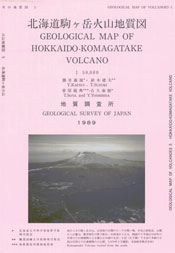Komagatake Volcano
1: Introduction / Geology of Komagatake Volcano and environs / Outline of Komagatake Volcano
2: Geology and history of activities of Komagatake Volcano
3: Eruptions of Komagatake Volcano in historical times
4: Rocks of Komagatake Volcano
5: Surveillance and observation of volcanc activities - Future surveillance and prevention of disaster
6: References
![]() PREV
PREV ![]() NEXT
NEXT
1: Introduction / Geology of Komagatake Volcano and environs / Outline of Komagatake Volcano
Introduction
Hokkaido-Komagatake ( hereafter abbreviated as Komagatake ) facing Funka-Wan Bay ( Uchiura-Wan ) in Oshima Peninsula, Hokkaido, has many eruptions in the record since 1640 ( 17th year of Kan-ei ) and one of the most active volcanoes in Japan. Especially notable was the eruption of 1640 in which tsunami was created in Funka-Wan due to collapsed mountaintop entering into the sea resulting in drowning of over 700 people. Pyroclastic flow in 1856 caused 20 strong casualties. Pyroclastic flow ( pumice flow ) in 1929 is world famous. Around Komagatake many beautiful sight spots are known including dammed lakes such as Onuma and Konuma and hot spas and the area has been designated as one of the quasi-national parks. In recent years the mountain foot areas have been under new development. However, the development projects should take natural hazard such as pyroclastic fall, pyroclastic flow, pyroclastic surge, and mud flow in addition to debris avalanche due to collapse of mountaintop into account.
This geologic map of the volcano is compiled from results of many previous studies with additions from our own studies. We do hope the map is useful for future scientific studies as well as disaster mitigation plan and regional development.
Geology of Komagatake Volcano and environs
The northern foot area of Komagatake Volcano faces Funka-Wan while in the south and west are about several hundred meters high hilly areas consisting of Neogene rocks. A low land, in which lakes such as Onuma, Konuma, and Junsai-Numa distributed, develops between Komagatake and hilly areas.
Nakanogawa Formation, Miocene in age, consists mostly of rhyolitic greentuff intercalated with mudstone and altered volcanic rocks, and distributed in Shikabe in the east and southeast. Pliocene ( partly Miocene? ) Togeshita volcaniclastic rocks comprise pyroxene andesite, hornblende andesitic tuff breccia, volcanic conglomerate, and lava intercalated with tuff and sandstone, widely distributed in the south. Interfingered with those and developed in the west of the mountain is Pliocene Oshironai Formation. This formation consists of tuffaceous sandstone in lower half and siltstone in upper half. Those Pliocene beds show syncline and anticline structures with their axes in NNW-SSE direction and cut by rhyolite and andesite bodies. In contrast, near Oritogawa River, SE of the volcano is distributed Pliocene Tomenosawa Formation consisting of rhyolitic tuff.
Near Torisakigawa, Mori, in western foot of the volcano, and further to the west is Pleistocene Mori Formation, while in SE foot Pleistocene Shikabe Formation is distributed on the right bank of Orito River. Those Pleistocene formations are un-solidified gravel and sand in addition to tuffaceous sand and silt forming several 10 to 100m high low hills. On the banks of Torisaki and Oshironai Rivers are developed low river terraces ( relative heights 20 to 25m and 5 to 10m ). Also along the right bank of Orito River, in SE foot, terraces with relative heights of 20 to 60 m are developed. The surfaces of those terraces are overlain by 2 to 3m thick sand and gravel beds. These are in turn covered by pyroclastic fall deposits from Komagatake. In western foot, Torisakigawa and Oshironai River areas, thick debris avalanche deposits cover the whole area.
In the foot areas of Komagatake, alluvial deposits are widely distributed. Those are mostly consisting of sand and gravel overlain by pyroclastic fall deposits from Komagatake. Also at the foot of the volcano, fan deposits of volcanic boulders, gravels, ash, and sand are widely developed.
Outline of Komagatake Volcano
Komagatake Volcano is 1,133 m high cone-shaped stratovolcano with its top blown away by an eruption. The foot is long and gently sloped with its base about 17 km in diameter. The horse-shoe shape summit crater is about 2 km across and open to the east and surrounded by peaks such as Sahara-Dake, Kenga-Mine, and Sumida-Mori. On the NE side of the summit is Oshidashizawa explosion crater. In the crater floor were a large oblong crater, Ansei crater ( 200m across ) and a small lava dome near the center before the explosion in 1929 ( 4th year of Showa ). Those were buried by thick pumice in 1929. Instead a large crater ( with weak fumarolic activity ) occupies the center with two small craters ( Hisago-shaped and Cocoon-shaped ) on its east side. A long fissure about 1.7 km long crossing the crater floor opened in 1942 ( 17th year of Showa ). Near the NW end of the fissure is 1942 crater.
The flanks of the volcano are covered by thick volcanic debris. Wave-like topography from pyroclastic surge exists on south and east slopes. Small protrusions on the flanks such as Nishi-Maruyama, Higashi-Maruyama, and Akahageyama are interpreted to be parasitic volcanoes, but the details are not known being buried in thick volcanic debris.
On the foot areas of the volcano, thick pumice fall and pyroclastic flow deposits are distributed along with well-developed volcanic fan deposits. Old and new debris avalanche deposits are seen forming characteristic hummocky hills on the foot areas. Many shallow lakes such as Onuma and Konuma in the southern foot area were formed by damming by Komagatake Volcanic ejecta.
In this volcanic geologic map, distributions of lava ( only shown in summit area ), debris avalanche deposit, pyroclastic flow, and pyroclastic surge are shown in colors, and that of pyroclastic fall is represented by isopachs.
![]() PREV
PREV ![]() NEXT
NEXT
